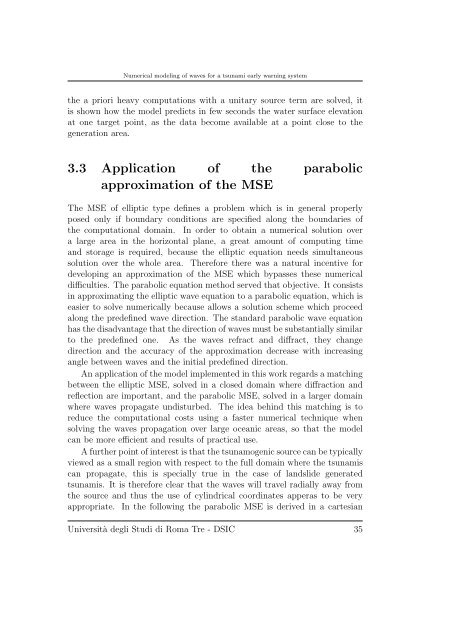Numerical modeling of waves for a tsunami early warning system
Numerical modeling of waves for a tsunami early warning system
Numerical modeling of waves for a tsunami early warning system
You also want an ePaper? Increase the reach of your titles
YUMPU automatically turns print PDFs into web optimized ePapers that Google loves.
<strong>Numerical</strong> <strong>modeling</strong> <strong>of</strong> <strong>waves</strong> <strong>for</strong> a <strong>tsunami</strong> <strong>early</strong> <strong>warning</strong> <strong>system</strong><br />
the a priori heavy computations with a unitary source term are solved, it<br />
is shown how the model predicts in few seconds the water surface elevation<br />
at one target point, as the data become available at a point close to the<br />
generation area.<br />
3.3 Application <strong>of</strong> the parabolic<br />
approximation <strong>of</strong> the MSE<br />
The MSE <strong>of</strong> elliptic type defines a problem which is in general properly<br />
posed only if boundary conditions are specified along the boundaries <strong>of</strong><br />
the computational domain. In order to obtain a numerical solution over<br />
a large area in the horizontal plane, a great amount <strong>of</strong> computing time<br />
and storage is required, because the elliptic equation needs simultaneous<br />
solution over the whole area. There<strong>for</strong>e there was a natural incentive <strong>for</strong><br />
developing an approximation <strong>of</strong> the MSE which bypasses these numerical<br />
difficulties. The parabolic equation method served that objective. It consists<br />
in approximating the elliptic wave equation to a parabolic equation, which is<br />
easier to solve numerically because allows a solution scheme which proceed<br />
along the predefined wave direction. The standard parabolic wave equation<br />
has the disadvantage that the direction <strong>of</strong> <strong>waves</strong> must be substantially similar<br />
to the predefined one. As the <strong>waves</strong> refract and diffract, they change<br />
direction and the accuracy <strong>of</strong> the approximation decrease with increasing<br />
angle between <strong>waves</strong> and the initial predefined direction.<br />
An application <strong>of</strong> the model implemented in this work regards a matching<br />
between the elliptic MSE, solved in a closed domain where diffraction and<br />
reflection are important, and the parabolic MSE, solved in a larger domain<br />
where <strong>waves</strong> propagate undisturbed. The idea behind this matching is to<br />
reduce the computational costs using a faster numerical technique when<br />
solving the <strong>waves</strong> propagation over large oceanic areas, so that the model<br />
can be more efficient and results <strong>of</strong> practical use.<br />
A further point <strong>of</strong> interest is that the tsunamogenic source can be typically<br />
viewed as a small region with respect to the full domain where the <strong>tsunami</strong>s<br />
can propagate, this is specially true in the case <strong>of</strong> landslide generated<br />
<strong>tsunami</strong>s. It is there<strong>for</strong>e clear that the <strong>waves</strong> will travel radially away from<br />
the source and thus the use <strong>of</strong> cylindrical coordinates apperas to be very<br />
appropriate. In the following the parabolic MSE is derived in a cartesian<br />
Università degli Studi di Roma Tre - DSIC 35

















